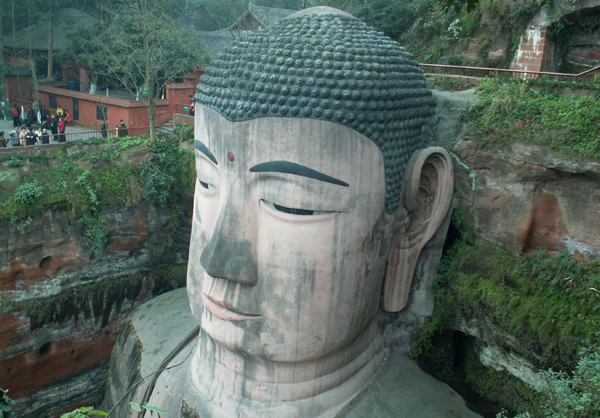Leshan Giant Buddha
The Leshan Giant Buddha (or Leshan Dafo) is a statue of Maitreya (a Bodhisattva usually represented as a very stout monk with a broad smile on his face and with his naked breast and paunch exposed to view) in sitting posture. Located where the Min, Qingyi, and Dadu River meet in Leshan, Sichuan Province, the Leshan Giant Buddha is a marvel of artistic ingenuity. In December, 1996, the location of the Buddha was included by UNESCO on the list of the World Heritage sites.
Taking over 90 years to carve, the statue was begun in 713, in the Tang Dynasty (618-907). During these years, thousands of workers had expended their efforts and wisdom on the project. As the biggest carved stone Buddha in the world, Leshan Giant Buddha is featured in poetry, song and story. Facing the river, the Buddha has symmetrical posture and looks which have been beautifully captured in its solemn stillness. The statue is 71 meters high and took thousands of workers to carve it. The statue's instep is large enough for one hundred people to sit on it and a single shoulder is as large as a basketball court.
Construction was begun by a Hai Tong, a Buddhist Monk who saw how many boats were sunk where the three rivers met and he believed that the Buddha would help calm the water and save lives, so he started the project. He raised money for the project by begging alms for 20 years. When he had enough money,construction began. He died while construction was not yet complete and his two disciples took over until it was finished.
The artistry of the Leshan Giant Buddha is all the more impressive when visitors discover what architectural achievements were built into the statue. The over 1,000 buns in the Buddha’s hair are separate pieces that were carved and hoisted into place by hand. The hair buns, ears, and clothing folds work together as a drainage system to drain water away from the statue to help preserve it. The ears of the statue are 7 meters tall and are made of plastered wood which had to be attached to the stone head.
The charm of the Buddha lies not only in its size but also in its architectural artistry. There are 1,021 buns in the Buddha's coiled hair. These have been skillfully embedded in the head. The skill is so wonderful that the 1,021 buns seem integral to the whole. Another architectural highlight is the drainage system. This system is made up of some hidden gutters and channels, scattered on the head and arms, behind the ears and in the clothes. This system, which helps displace rainwater and keep the inner part dry, plays an important part in the protection of the Buddha. The large pair of ears, each seven meters (about 23 feet) long, is made of wood and is decorated by mud on the surface. For craftsmen of thousands of years ago, it was not easy to fix these to the stone head.
Having such a long history and such worldwide fame, the renovation of the Buddha has received extensive attention both at home and abroad. The Buddha was nearly destroyed by the erosion of wind and rain before 1963 when the Chinese government began the repairing work. At present, the maintenance work is in progress under the instruction of experts from UNESCO.
Get There:
Railway: To get to Leshan by train, get off at Emei station. This station is 10 kilometers (about six miles) away from the gate of Mt. Emei, and 31 kilometers (about 19 miles) away from Leshan City.
Road: It is 162 kilometers (about 100 miles) from Chengdu City to Leshan City if one travels by the expressway. Emei City and Leshan City, with a distance of 31 kilometers (about 19 miles) are connected by a freeway, and there is a regular bus every ten minutes. Besides, there are buses to Chongqing City, Neijiang City, Zigong City, Yibin City and Ya'an City from Leshan City. Buses to nearby counties are also available.
By water: There are very many ferries to the site of Leshan Giant Buddha every day. Ferries to Yibin City, Luzhou City and Chongqing City are available at
Leshan Port. By air: Chengdu Shuangliu International Airport (CTU) is 150 kilometers (about 93 miles) away from Leshan City by freeway. Many train and air ticket offices are set up in the city.


.jpg)












